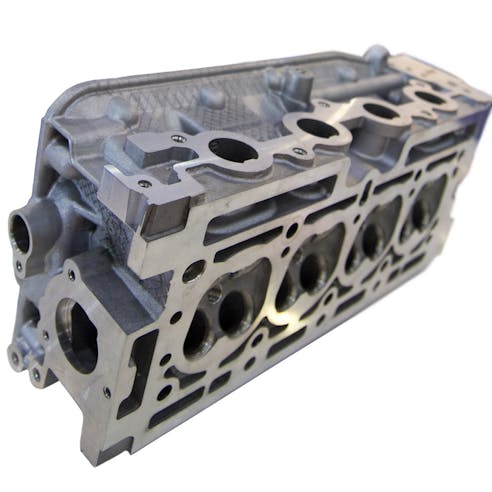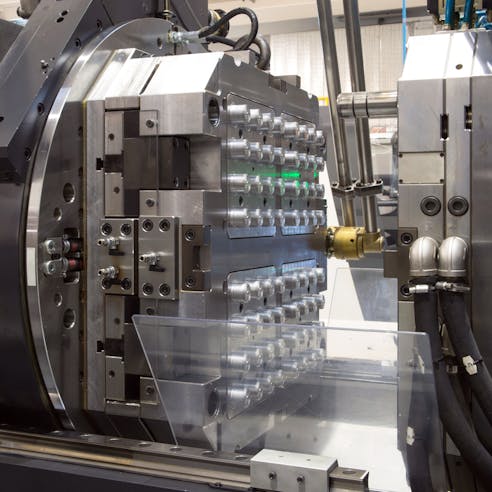Ductile Iron Casting Services by Xometry
Get custom ductile iron casted prototypes and production parts in as few as five business days. Dozens of materials and finishes are available. ISO 9001:2015, ISO 13485, IATF 16949:2016, and AS9100D certified.
Ductile iron, also known as nodular or spheroidal graphite iron, stands out for its remarkable mechanical properties. Its ability to withstand high levels of stress and strain, coupled with excellent wear resistance, makes it a preferred choice in demanding environments. As a result, ductile iron castings are essential components in industries such as automotive, in which they form critical parts of engines, chassis, and transmissions. In construction, ductile iron pipes ensure the reliable distribution of water and sewage. In machinery and renewable energy sectors, ductile iron's resilience ensures the longevity of key components, while in transportation, it enhances safety and performance.
At Xometry, we specialize in harnessing the potential of ductile iron to deliver top-notch castings that exceed industry standards. Our commitment to precision casting and foundry services ensures that every component we produce embodies the exceptional quality and reliability that ductile iron is known for.
Ductile Iron Casting Process
The ductile iron casting process begins with the melting of high-quality pig iron and scrap steel in a state-of-the-art induction or cupola furnace. The temperature and composition of the molten metal are closely monitored and controlled to achieve the desired chemical composition and temperature for ductile iron production. Once these conditions are met, the molten metal undergoes a series of treatments to refine its properties. This includes the addition of nodulizing agents such as magnesium to promote the formation of graphite nodules within the iron matrix.
Our foundry techniques include meticulous mold preparation. The mold is typically made from sand, which is compacted around a pattern to create the desired shape of the final product. The molten metal is poured into the mold cavity under controlled conditions. The pouring process is closely monitored to ensure that the metal fills the mold completely and evenly. As the molten metal cools and solidifies inside the mold, the ductile iron casting takes shape. After the casting has cooled, it is removed from the mold in a process known as shakeout. Any excess sand and sprues are removed, and the casting is cleaned to prepare it for further processing.
Depending on the specific requirements of the casting, it may undergo heat treatment processes such as: annealing, quenching, or tempering to further refine its mechanical properties and relieve residual stresses.
Our commitment to casting quality involves rigorous inspection and quality control at every stage of production. This includes: visual inspections, dimensional checks, and non-destructive testing techniques like ultrasonic testing and magnetic particle inspection to ensure that each casting meets the specified standards. For precision parts, machining and finishing processes are employed to achieve the final dimensions and surface quality.
Custom Ductile Iron Castings
At Xometry, our expertise extends beyond standard offerings to provide custom ductile iron castings tailored precisely to the unique needs of our clients. We understand that each project is unique, and we take pride in our precision engineering capabilities that allow us to craft bespoke casting solutions.
Our commitment to meeting specific requirements is at the core of what we do. We work closely with our clients to understand their project's intricacies and challenges. This collaborative approach enables us to develop customized casting solutions that align perfectly with their vision.
Properties of Ductile Iron
| Property | ASTM A536, GRADE 60-40-18 | ASTM A536, GRADE 65-45-12 | ASTM A536, GRADE 80-55-06 |
|---|---|---|---|
Property Tensile Strength, min (MPa) | ASTM A536, GRADE 60-40-18 414 | ASTM A536, GRADE 65-45-12 448 | ASTM A536, GRADE 80-55-06 552 |
Property Yield Strength, min (MPa) | ASTM A536, GRADE 60-40-18 276 | ASTM A536, GRADE 65-45-12 310 | ASTM A536, GRADE 80-55-06 379 |
Property Elongation in 2 in. or 50 mm, min % | ASTM A536, GRADE 60-40-18 18 | ASTM A536, GRADE 65-45-12 12 | ASTM A536, GRADE 80-55-06 6 |
Property Density (g/cm3) | ASTM A536, GRADE 60-40-18 7.1 | ASTM A536, GRADE 65-45-12 7.1 | ASTM A536, GRADE 80-55-06 7.1 |
Property Melting Temperature (°C) | ASTM A536, GRADE 60-40-18 1,150–1,200 | ASTM A536, GRADE 65-45-12 1,150–1,200 | ASTM A536, GRADE 80-55-06 1,150–1,200 |
Property Compressive Strength (MPa) | ASTM A536, GRADE 60-40-18 2960 | ASTM A536, GRADE 65-45-12 2960 | ASTM A536, GRADE 80-55-06 2960 |
Property UNS | ASTM A536, GRADE 60-40-18 F32800 | ASTM A536, GRADE 65-45-12 F33100 | ASTM A536, GRADE 80-55-06 F33800 |
Property Corrosion resistance | ASTM A536, GRADE 60-40-18 Good | ASTM A536, GRADE 65-45-12 Good | ASTM A536, GRADE 80-55-06 Good |
Table Credit: https://www.reliance-foundry.com/blog/ductile-iron
Ready to make custom ductile iron casted parts?
Advantages of Ductile Iron Castings
Ductile iron castings offer several benefits, including:
Casting Strengths
Ductile iron castings offer remarkable casting strengths, including: high tensile strength, exceptional durability, and impressive impact resistance. With its high tensile strength, ductile iron can withstand heavy loads and mechanical stresses. Its durability ensures resistance to wear and abrasion, contributing to extended service life. Moreover, ductile iron's exceptional impact resistance means it can absorb and dissipate energy effectively. Besides this, ductile iron has exceptional fatigue resistance and also offers excellent ductility, which allows it to bend and flex without fracturing.
Versatility
Ductile iron's adaptability and design flexibility find applications across engineering sectors. In the automotive industry, it excels in engine components, suspension parts, and brake components due to its exceptional strength and wear resistance. In infrastructure, ductile iron pipes and fittings are the preferred choice for water and wastewater systems, offering corrosion resistance and longevity. Agriculture benefits from its durability in farm machinery like plowshares and tillage equipment. Additionally, in construction, ductile iron is vital for structural components such as: columns, beams, and drain covers. Its wide applicability and adaptability meet specific project requirements with precision and reliability, making it a versatile material in engineering applications.
Corrosion Resistance
Ductile iron offers good corrosion resistance, which is better than that of unalloyed steel and highly alloyed steel in some environments. This makes it an ideal material for applications that require resistance to harsh environments, such as exposure to chemicals, saltwater, and other corrosive environments, including most soils, without deteriorating. It also has good rust resistance. This contributes to its environmental durability and long service life.
Overall Cost-Efficiency
Although more expensive than cast iron, ductile iron castings stand out as a cost-effective material choice for tougher parts, leading to reduced maintenance requirements and a lower total cost of ownership. This advantage in terms of cost-effectiveness can be attributed to several key factors. Firstly, ductile iron’s exceptional castability and precision casting capabilities significantly reduce the requirement for extensive machining during the production process. This not only streamlines manufacturing but also leads to cost savings.
Secondly, ductile iron castings exhibit superior durability and corrosion resistance, resulting in a longer service life for components. This longevity translates to reduced maintenance and replacement costs over time, making ductile iron a cost-efficient choice even with its higher price tag compared to cast iron. It is, however, cheaper than steel, but also more difficult to cast.
Lastly, ductile iron's high strength-to-weight ratio allows for the design of lighter components that are just as robust, ultimately decreasing material and transportation expenses.
Strength-to-weight Ratio
It weighs approximately 10% less than some competing steel alloys, and this reduced weight plays a significant role in its widespread acceptance, as it enables cost-effective shipping for manufacturers in specific scenarios.
Machinability
Ductile cast iron is easier to machine than steel or aluminum, thanks to its lower hardness and superior lubrication properties. This characteristic can lead to time and cost savings in the manufacturing process.
Casting Characteristics
Ductile iron exhibits exceptional fluidity, allowing it to perfectly fill intricate molds with fine details and thin sections. It can also be cast in larger dimensions without the risk of porosity or cracking.
Disadvantages of Ductile Iron Castings
While ductile iron castings have their advantages, they also have some casting limitations to consider such as those listed below:
Costs in Comparison to Cast Iron
Ductile iron is generally more expensive than gray cast iron, primarily due to its complicated chemical makeup and the more complex casting process required to produce it. This can make it less cost-effective for some applications. However, it is still cheaper than steel and can be worth the investment for applications that require a tougher material.
Brittle Characteristics
Despite its higher ductility compared to gray iron, ductile iron can exhibit sudden and unexpected fractures when subjected to significant impact, rendering it unsuitable for applications or structures sensitive to shock.
Welding Challenges
Ductile iron poses welding difficulties due to its elevated carbon content, propensity to crack, and limited heat conductivity. Specialized techniques, including preheating and post-weld heat treatment, are necessary to avert welding defects.
Inconsistent Properties
Ductile iron is susceptible to variations in its mechanical and physical properties, contingent on factors like the manufacturing process, alloy composition, and cooling rate. These variations can impact its dependability and performance in critical applications.
Environmental Considerations
The production of ductile iron entails substantial energy consumption and the emission of greenhouse gasses such as carbon dioxide and methane. Furthermore, dealing with ductile iron scrap disposal and recycling presents challenges due to the presence of toxic elements like lead, chromium, and nickel within the alloy.
Applications of Ductile Iron Castings
Ductile iron castings have very versatile applications in both industrial sectors and engineering projects. It is predominantly used by plumbing manufacturers for the production of pipes and pipe fittings. Furthermore, the automotive sector extensively relies on ductile iron. They use it in critical engine components such as: connecting rods, cylinders, crankshafts, truck axles, and gears. Some of the common applications of ductile iron castings include:
- Automotive Industry
- Construction and Infrastructure
- Machinery and Equipment
- Renewable Energy
- Railway and Transportation

Automotive Industry
Ductile iron castings are widely used in the automotive industry for manufacturing essential components such as: engine blocks, transmission parts, and various automobile components. Their strength and wear resistance ensure durable and reliable vehicle performance.
Construction and Infrastructure
In construction and infrastructure projects, ductile iron castings find crucial applications in: pipes, fittings, sewage systems, and drain covers. Their robustness and corrosion resistance make them ideal for maintaining reliable water distribution and sewage networks while supporting infrastructure integrity.
Machinery and Equipment
Ductile iron castings are integral to machinery and equipment production, including: manufacturing machinery, agricultural equipment, and industrial machines. Their strength and durability enhance the performance and longevity of these critical components.
Renewable Energy
Ductile iron castings also find application in renewable energy sectors. It provides the strength and reliability needed for: wind turbine components, hydroelectric applications, and solar infrastructure, contributing to the growth of sustainable energy sources.
Railway and Transportation
In the railway and transportation industry, ductile iron castings are essential for: railroad track components, locomotive parts, and transit systems. Their durability and structural integrity ensure the efficiency and safety of transportation networks.
Alternatives to Ductile Iron Castings
When considering alternatives to ductile iron castings, several materials come into play, each with its own unique advantages and disadvantages. Let's explore these alternatives:
- Cast Iron Castings
- Steel Castings
- Aluminum Castings
- Bronze Castings

Cast Iron Castings
Cast iron castings offer several advantages, including high compressive strength and excellent vibration-damping properties. This makes them particularly well-suited for applications that require robust components capable of withstanding heavy loads and minimizing vibrations. Additionally, cast iron castings are often a cost-effective choice compared to some other materials, making them appealing in various industries. However, they do come with some drawbacks, such as brittleness, which can result in fracture under impact. Cast iron is also relatively heavy, which can be a consideration in weight-sensitive applications. Moreover, without proper treatment, cast iron is susceptible to corrosion. Common applications of cast iron castings include: engine blocks, pipes, drain covers, and cookware due to their strength and heat retention properties.
Steel Castings
Steel castings are valued for their exceptional tensile strength and durability, making them a preferred choice in industries that demand robust materials. They are versatile and can be alloyed to exhibit a wide range of properties, making them suitable for diverse applications. Furthermore, steel, especially stainless steel, offers strong corrosion resistance. However, it's important to note that steel castings can be heavy, similar to cast iron. Additionally, the cost of steel can be higher than some alternative materials, and machining may require special tools. Steel castings are widely used in industries such as: automotive, aerospace, construction, and marine due to their strength and longevity.
Aluminum Castings
Aluminum castings are recognized for their lightweight nature, making them invaluable in applications in which weight reduction is a priority. They also boast excellent machinability, making them easy to work with during manufacturing processes. Aluminum naturally forms a protective oxide layer, enhancing its corrosion resistance. However, aluminum is not as strong as iron or steel, which can limit its use in heavy-duty applications. Its lower melting temperature should also be considered. High-quality aluminum alloys can be relatively costly. Industries such as: aerospace, automotive, and consumer goods frequently utilize aluminum castings to benefit from reduced weight and corrosion resistance.
Bronze Castings
Bronze castings are known for their corrosion resistance, particularly in marine environments, making them an excellent choice for components exposed to moisture. They also exhibit excellent bearing properties, including self-lubrication capabilities, making them suitable for bearings and bushings. Additionally, bronze is often chosen for its attractive appearance, making it a popular choice for decorative and artistic applications. However, bronze may not have the same strength as iron or steel, limiting its use in high-stress applications. It can also be relatively expensive, and machining may pose some challenges due to its hardness. Common applications of bronze castings include: marine components, sculptures, musical instruments, and various bearing applications in which corrosion resistance and unique properties are highly valued.
Why Choose Xomety for Ductile Iron Castings?

Endless Options
Choose from millions of possible combinations of materials, finishes, tolerances, markings, and certifications for your order.

Easy to Use
Get your parts delivered right to your door without the hassle of sourcing, project management, logistics, or shipping.

Quality Assurance
We are ISO 9001:2015, ISO 13485, IATF 16949:2016, and AS9100D certified.